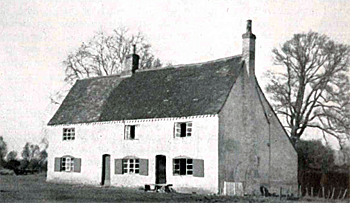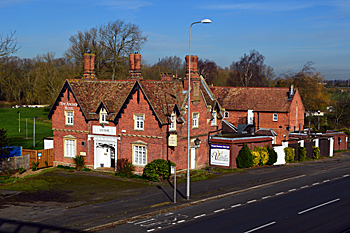The Anchor Hotel Tempsford

Ferry Cottage in 1953 from The Bedfordshire Magazine
There have been two inns of this name in Tempsford. The first stood a little behind the more recent building, close to the river and the original route of the Great North Road. The building still stands and was listed by the former Ministry of Works in January 1952 as Grade II, of special interest. The oldest parts are thought to date from the 17th century and the building is timber-framed and mostly cased in colour-washed brick, with clay tiled roofs. The building, later called Ferry Cottages, stands some yards north-west of the present inn.
The earliest known references to the Anchor date from September 1794 when John Byng, 5th Viscount Torrington stayed there with a party whilst fishing on the Ouse. His diary entries for this month contain several references to The Anchor and even include a transcribed receipt for expenses submitted by the then landlord Edward George. Because of its closeness to the river the old Anchor was occasionally referred to as the Ferry House although Edward George’s great grandson told The Bedfordshire Times that in earlier times it had also been known as The Boy And The Oar, in reference to the nearby ferry crossing [Bedfordshire Times, 21 July 1889].
An 1810 valuation of Sir Gillies Payne’s Tempsford estates contains the earliest written reference held at Bedfordshire Archives [BS1486]. In this document Edward George’s property is described as “a public house near the bridge, a stable and a close at the back of the house, a meadow by the river, ozier bed and a narrow slip over the river.” George rented these from Payne for an annual rent of £15 15s. George died in 1820 but his wife Alice took over the tenancy of the inn [ABP/W1820/44] and was still there when the Paynes sold their Tempsford properties four years later. The catalogue advertising the sale of the estate refers to: “A PUBLIC HOUSE , known as the Sign of the ANCHOR, with stabling and outbuildings, yard, garden and sundry pieces of meadow, pasture and arable land and ozier ground containing ten acres, three roods and ten perches, in the occupation of Mrs Alice George at £24 per annum” [WG2495]. The inn closed, possibly sometime in the late 1820s, after the Great North Road was diverted away from this part of the river towards the new Tempsford Bridge to the north.

The Anchor Hotel February 2016
In 1831 the Stuart family, who had purchased the estate in 1824, built a new inn closer to the road where it could pick up more business. It opened with much celebration on the 4th July 1831 [Bedfordshire Magazine Volume III, page 273]. The new building was also known as The Anchor, later The Anchor Hotel, and Alice George was its first tenant. It was a much grander property than its predecessor; a 1913 auction catalogue shows that it had a tea room, kitchen, tap room, smoke room, private office, sitting room, dining hall, eight bedrooms, larder and dairy, as well as sheds, stables and other outbuildings [WY923/5]. Alice Edwards remained at The Anchor until her death in 1839 when it passed firstly to her son Martin and, on his death in 1879, to his son of the same name. In all, the George family are known to have rented The Anchor for at least 117 years, probably even longer.
Martin George junior retired early in 1911 and moved into the old Anchor which had by this time been converted into cottages [WY923/1-4]. The hotel was re-decorated, the rent raised to £90 a year, and a series of short term tenants took up residence. The Stuart family papers reveal that there followed a difficult time for The Anchor Hotel and its owners. The marital problems of one of George’s successors, the son of a Peterborough mayor, caused great consternation when rumours of his wife’s affair with another Tempsford man reached the Stuart estate office. The estate steward and his employer discussed at great length whether “moral misbehaviour on the part of [the publican’s] wife with one of Colonel Stuart’s tenants is a good and sufficient reason for giving him notice” but agreed that it would “be best to get rid of them quietly”to avoid further scandal[WY923/15]. The tenant had recently asked for a reduction in rent, on the grounds that the hotel was losing money, and this provided the Stuarts with a convenient excuse for letting him out of the tenancy agreement early. The effects of the affair lingered for some time and his replacement at the hotel later complained that the continued presence of the third party involved was still causing resentment among the customers: “He has done the Hotel a good deal of harm and there is a lot of scandal about how he has been carrying on etc. So I have told him that he is not to come here anymore as I will refuse to serve him as every one of the customers refuse to associate with him…. I am sure it is to the best interests of the place”[WY923/16].
Another publican was also nearly sacked from the post after a disagreement with E. T. Delmege, who rented the shooting rights from the Stuart estate and regularly stayed at the hotel. In the summer of 1915 Delmege complained to the estate office about rising prices, the uncomfortableness of the rooms, and the insolence of the staff at the hotel, saying: “If I have to deal with [the landlord] again it will be a question if I take on the shoot if offered to me again.” In response the estate steward wrote to the landlord ending the tenancy and remonstrating: “I would point out to you that the shooting tenant – whoever that may be – is probably the most important person on the whole estate and in order to let the shooting satisfactorily it is absolutely necessary that the Anchor should be thoroughly comfortable, warm and well found with servants and good cooking as it used to be under previous management. Personally I can tell you for what it is worth that I narrowly escaped Bronchitis on two occasions this year when staying at the Anchor in consequence of the awful cold in my bedroom and sitting room.”
The landlord fought back, refusing to give up the tenancy, and protesting that he had reported the draught from the windows to the estate office on several occasions already. He continued: “I might mention we have had the distinguished patronage of two mayors, a Staff Captain and Lieutenant Commander, all on the staff of the War Office, almost weekly since July. From the very commendable attention they have received, [they] are booking rooms for Christmas. I am proud of this at a time when one’s honour & living is assailed; such testimony from honoured men as these, does much to mitigate the uncomfortable feeling this correspondence has caused.”
There are no further letters on the subject in the estate correspondence and it appears that the landlord was allowed to remain for the time being [WY923/18].
In 1927 The Anchor Hotel was valued under the 1925 Rating Valuation Act. The property was still owned by the Stuart estate at the time and let to Arthur Albert Spiers. The surveyor’s notes describe it as a free house with a 6 day license, water laid on and electric light from its own plant. Some of the land nearby was liable to flooding and the landlord appeared to keep no books. Yearly takings could be estimated only at around £800 to £900 per year, which the surveyor thought rather low [DV1/C157/4].
The Anchor Hotel remained in the hands of the Stuart family until the 1970s when it was sold to Hamilton Taverns who in turn sold it to Scottish & Newcastle Breweries. It is now a private club known as The Vanilla Alternative.

The Anchor Hotel three-quarter view February 2016
References to documents held by Bedfordshire & Luton Archives & Records Service
- BS1486: Particulars and valuation of the estate at Tempsford 1810;
- ABP/W1820/44: Will of Edward George, innkeeper of Tempsford 1820;
- WG2495: Particulars of Tempsford estate to be sold at auction 1824 (additional copies: WY1036/21/10, WY279);
- CL/P13: Register of alehouse licenses 1822-1828;
- CL/P19/1: Return of licensed premises 1876;
- CL/P19/2: Return of licensed premises 1891;
- CL/P20: Return of licensed premises 1903 ;
- PSBW8/1: Licensing Register 1903 – 1915;
- WY923/1-19: Correspondence concerning The Anchor Hotel, Tempsford 1911 – 1917;
- PSBW8/2: Licensing Register 1915 – 1972;
- WY1036/17/8-11: Counterpart leases for The Anchor 1928 – 1934;
- PSBW8/3: Licensing Register 1976 – 1980;
- PL/P/MB78/358A: Plan of proposed alterations to The Anchor Hotel 1978;
- PSBW8/4: Licensing Register c. 1957 – 1995;
- The Inn Keeping Taylors of Tempsford by C. E. Taylor, Beds Magazine III
Licensees: note that this is not a complete list and that dates in italics are not necessarily beginning or end dates, merely the first/last date which can be confirmed from sources such as directories and deeds.
1794-1820: Edward George;
1820-1839: Alice George;
1839-1879: Martin George senior;
1879-1911: Martin George junior;
1911-1913: Francis Henry Nichols;
1913: Thomas Roberts;
1913-1928: Arthur Albert Spiers;
1928: Frank Herbert Richards;
1931-1934: Doris Grace Bradshaw;
1936-1940: Edward Fox Overbury;
1966-1979: Barbara, John Lake and Keith Lake Wilson;
1979-1989: Roger William Wells;
1989-1992: Garry Colin Levins, Michael Charles Barham;
1992-1993: Garry Colin Levins, Timothy Andrew Bird;
1993: Garry Colin Levins, Philip Andrew Griffiths ;
1993-1994: Stephen Yould, Philip Andrew Griffiths;
1994: Ian Douglas Rowe, Mark Andrew Griffiths